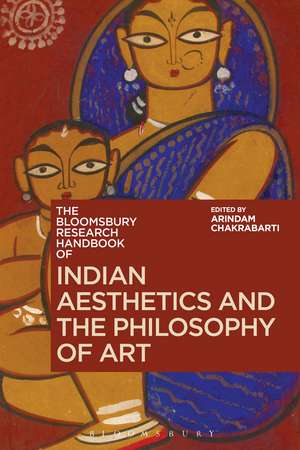The Bloomsbury Research Handbook of Indian Aesthetics and the Philosophy of Art: Bloomsbury Research Handbooks in Asian Philosophy
Editat de Professor Arindam Chakrabartien Limba Engleză Paperback – 7 feb 2018
| Toate formatele și edițiile | Preț | Express |
|---|---|---|
| Paperback (1) | 263.93 lei 6-8 săpt. | |
| Bloomsbury Publishing – 7 feb 2018 | 263.93 lei 6-8 săpt. | |
| Hardback (1) | 869.32 lei 6-8 săpt. | |
| Bloomsbury Publishing – 24 feb 2016 | 869.32 lei 6-8 săpt. |
Preț: 263.93 lei
Preț vechi: 298.74 lei
-12% Nou
Puncte Express: 396
Preț estimativ în valută:
50.50€ • 52.73$ • 41.80£
50.50€ • 52.73$ • 41.80£
Carte tipărită la comandă
Livrare economică 04-18 aprilie
Preluare comenzi: 021 569.72.76
Specificații
ISBN-13: 9781350058026
ISBN-10: 1350058025
Pagini: 440
Ilustrații: 37 b/w illustrations. 5 colour illustrations. 2 line drawings.
Dimensiuni: 156 x 234 x 27 mm
Greutate: 0.68 kg
Editura: Bloomsbury Publishing
Colecția Bloomsbury Academic
Seria Bloomsbury Research Handbooks in Asian Philosophy
Locul publicării:London, United Kingdom
ISBN-10: 1350058025
Pagini: 440
Ilustrații: 37 b/w illustrations. 5 colour illustrations. 2 line drawings.
Dimensiuni: 156 x 234 x 27 mm
Greutate: 0.68 kg
Editura: Bloomsbury Publishing
Colecția Bloomsbury Academic
Seria Bloomsbury Research Handbooks in Asian Philosophy
Locul publicării:London, United Kingdom
Caracteristici
Provides an in-depth historical overview of Indian Aesthetics, anticipating new research directions
Notă biografică
Arindam Chakrabarti is Professor of Philosophy at the University of Hawai'i, Manoa, USA.
Cuprins
Notes on ContributorsIntroduction: Contemporary Indian Aesthetics and Philosophy of Art, Arindam Chakrabarti (University of Hawaii, Manoa, USA)1. Two Cultures in Indian Epistemology of Aesthetic Meaning, Lawrence McCrea (Cornell University, USA)2. Rasa Aesthetics goes Global: Relevance and Legitimacy, Priyadarshi Patnaik (Indian Institute of Technology Kharagpur, India)3. Who is afraid of Mimesis? Contesting the Common Sense of Indian Aesthetics through the Theory of 'Mimesis' or Anukarana Vâda, Parul Dave Mukherji (School of Aesthetics and Art History, JNU, New Delhi, India)4.Thoughts on Svara and Rasa: Music as Thinking/Thinking as Music, Mukund Lath (Jaipur, India)5. The Aesthetics of the Resplendent Sapphire: Erotic Devotion in Rupa Gosvamin's Ujjvalanilamani, Nrisinha Prasad Bhaduri (Kolkata, India)6. The Impersonal Subjectivity of Aesthetic Emotion, Bijoy H Boruah (Indian Institute of Technology Delhi, India)7. Refining the Repulsive: Towards an Indian Aesthetics of the Ugly and the Disgusting, Arindam Chakrabarti (University of Hawaii, Manoa, USA)8. The Perfume of/from the Past: Modern Reflections on Ancient Art, Sudipta Kaviraj (Columbia University, USA)9. Aesthetics of Theft, Sibaji Bandyopadhyay (Formerly, Professor of Cultural Studies, Centre for Studies in Social Sciences, Calcutta, India)10. Approaches to Time in Rajput and Mughal painting, B.N.Goswamy (Emeritus Professor of Aesthetics and Art-History, Punjab University Chandigarh, India)11. Deep Seeing: Notes on Kutiyattam, David Shulman (The Hebrew University, Jerusalem)12. Realizing the body in movement: Gestures of Freedom in the Dance Aesthetics of Rabindranath Tagore and Kumar Shahani, Rimli Bhattacharya (University of Delhi, India)13. The Aesthetical Paradox of the Hermit's Hut, Kazi Khaleed Ashraf (University of Hawaii, Manoa, USA)14. Aesthetics of Touch and Skin: An Essay in Contemporary Indian Political Phenomenology, Gopal Guru (Jawaharlal Nehru University, India)15. Demands and Dilemmas of Durga Puja 'Art': Notes on a Contemporary Festival Aesthetics, Tapati Guha-Thakurta (Centre for Studies in Social Sciences, Calcutta)16. The Sky of Cinema, Moinak Biswas (Jadavpur University, India)17. Towards a Gandhian Aesthetics: The Poetics of Surrender and the Art of Brahmacharya, Tridip Suhrud (Sabarmati Ashram Preservation and Memorial Trust, India)18. Aesthetic Judgement of Disgrace, Gayatri Chakravorty Spivak (Columbia University, USA)BibliographyIndex
Recenzii
A very good anthology, covering a substantial range of Indian aesthetic concerns. . I recommend it to anyone wanting a sense of the history and present, and of the philosophical richness of Indian aesthetic theory.
[A] positive contribution to the discourse on aesthetics from a cross-cultural perspective. It should be required reading for any academic who teaches and writes on aesthetics and the philosophy of art. It should also attract any reader interested in seeing how a familiar topic in Western aesthetics-like the possibility and nature of aesthetic experience-is treated in sometimes unfamiliar ways in a cross-cultural context by aestheticians writing about Indian music, theater, dance, painting, and film. There is much to be inspired by, and to learn from, in a careful perusal of this volume.
Unlike the many works that take Western viewpoints as their starting point, this collection presents Indian aesthetics from the inside, demonstrating its depth, versatility, and contemporary relevance. It welcomes novices while simultaneously addressing experts, covering traditional issues as well as such intriguing topics as the aesthetic value of the ugly, the aesthetics of festivals, the architectural character of hermits' huts, and the role of aesthetics in post-colonial politics. This book is essential reading, not only for those specifically concerned with the Indian tradition, but for anyone who is interested in aesthetics and the arts.
This volume of essays offers a synthetic and creative approach to the subject of Indian aesthetics and the philosophy of art. The editor has gathered together essays that intersect hosts of themes that are omnipresent in Indian works of literature, music, stage drama, cinema, and the plastic arts alongside theoretical reflections on the cognitive, emotional, cross-cultural, political, and social aspects of the aesthetic in Indian art across time. As such, this collection of essays moves past any attempt at predictable coherence or coverage and ambitiously aims to provoke new thoughts about aesthetics in the South Asian context, a subject so ancient and so vast that no single volume could justifiably introduce its variety.
[A] positive contribution to the discourse on aesthetics from a cross-cultural perspective. It should be required reading for any academic who teaches and writes on aesthetics and the philosophy of art. It should also attract any reader interested in seeing how a familiar topic in Western aesthetics-like the possibility and nature of aesthetic experience-is treated in sometimes unfamiliar ways in a cross-cultural context by aestheticians writing about Indian music, theater, dance, painting, and film. There is much to be inspired by, and to learn from, in a careful perusal of this volume.
Unlike the many works that take Western viewpoints as their starting point, this collection presents Indian aesthetics from the inside, demonstrating its depth, versatility, and contemporary relevance. It welcomes novices while simultaneously addressing experts, covering traditional issues as well as such intriguing topics as the aesthetic value of the ugly, the aesthetics of festivals, the architectural character of hermits' huts, and the role of aesthetics in post-colonial politics. This book is essential reading, not only for those specifically concerned with the Indian tradition, but for anyone who is interested in aesthetics and the arts.
This volume of essays offers a synthetic and creative approach to the subject of Indian aesthetics and the philosophy of art. The editor has gathered together essays that intersect hosts of themes that are omnipresent in Indian works of literature, music, stage drama, cinema, and the plastic arts alongside theoretical reflections on the cognitive, emotional, cross-cultural, political, and social aspects of the aesthetic in Indian art across time. As such, this collection of essays moves past any attempt at predictable coherence or coverage and ambitiously aims to provoke new thoughts about aesthetics in the South Asian context, a subject so ancient and so vast that no single volume could justifiably introduce its variety.























